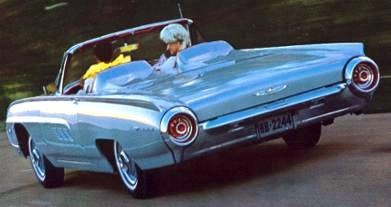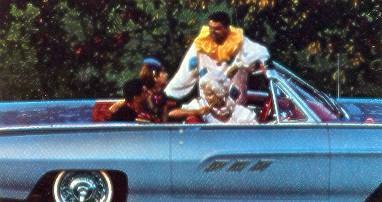| 1962-1963 Ford Thunderbird Sports Roadster: What Went Wrong? |
|
 Foreground: 1963 Thunderbird Sports Roadster in Silver Mink Metallic; in background: Corinthian White |
|
|
What went wrong with the Sports Roadster? In the beginning, it seemed like the perfect answer to all of the concerns voiced in the years since the two passenger T-Birds were introduced. Capable of changing from a sleek, sporty two passenger convertible to a four passenger convertible in a matter of minutes, it also had the ability to have the top up or down with or without the fiberglass Tonneau Cover in place. The top was fully automatic with the exception of zipping or unzipping and rolling up or down the back window, and clamping or unclamping the windshield header top clamps. Factory SelectAire Conditioning was available as an option to cool the interior, and storage space in the luggage compartment was adequate with the top up. Who embarks on a long trip with the top down, anyway? It would seem most of the objections to past Thunderbird models had been answered with this one model. So, what went wrong? After participating in this topic of discussion for many years, we can only conclude that the Sports Roadster was too expensive for typical Thunderbird customers. Priced at $5,439 without any extras, the 1962 Sports Roadster was $651 more than the Convertible, and a whopping $1,118 more than the Hardtop! For just $149 more, a Cadillac Sixty-Two Convertible could be had, with standard power windows and heater and defroster. The base Sports Roadster would not have been equipped with these items. It is important to remember that at this point, Ford was marketing the Thunderbird towards the lower end of the luxury market. Advertising of the period clearly pointed out that the Thunderbird cost less than any other true luxury car. Why was the Sports Roadster so expensive? Basically, it comes down to the Kelsey-Hayes Wire Wheels. We believe this one feature was the downfall of the Sports Roadster package. Now, there are a great many who believe these wheels are the most beautiful wheels ever created, and we aren't disagreeing with that. They would also say that the Sports Roadster would not be a Sports Roadster without the wire wheels. This is where we take exception. At $372.30, the Wire Wheels were the most expensive part of the Sports Roadster package. Without the wheels, the Sports Roadster would have been just $278.70 more than the Convertible, making it a more affordable model at a base price of $5,067. You could add optional MagicAire Heater-Defroster, power windows, windshield washer, whitewall tires, AM radio, and an outside mirror with a little change to spare for the difference in cost. The Wire Wheels were also associated with service problems and bad publicity from the very beginning, with complaints from customers about flat tires on their Roadsters due to slow air leaks. It wasn't good for public relations to have new Roadsters sitting in driveways with flat tires. To make it worse, several reports of wheel failure cropped up. One of the cars affected was Elvis Presley's Thunderbird Sports Roadster, which was one of the first Sports Roadsters built. Mr. Presley was at the peak of his popularity during this time, and in the Fall of 1961, had a Billboard Top 10 hit "(Marie's the Name of) His Latest Flame," which peaked at number four on the charts, and was filming the movie "Kid Galahad" in California. Presley was on a drive in his new Sports Roadster when one of the wheels collapsed, apparently while turning at a good rate of speed. This incident made the national headlines, and sent engineers at Ford and Kelsey-Hayes back to the drawing board to refigure wheel load and tolerance. It was determined that the spokes on the forty-eight spoke wheels were slightly undersize at 1/4 inch, and that the diameter of the spokes would need to be increased to 5/16 of an inch to allow for proper safety margins. Ford immediately recalled the wheels, fitting Sports Roadsters in the field with standard wheels and wheel covers until the new Kelsey-Hayes Wire Wheels could be manufactured and installed. This is proven by an episode on "The Twilight Zone," titled "Showdown with Rance McGrew" which had an original air date of February 2, 1962. This episode was filmed and copyrighted in 1961, and featured one of the first Corinthian White 1962 Thunderbird Sports Roadsters built, complete with all of the Roadster accoutrements--with the exception of the wire wheels. Standard wheels and full wheel covers were provided. Apparently this episode was filmed during the wire wheel recall period. In addition, the wire wheels were not capable of holding air, which meant inner tubes were required on the wire wheels. Tubeless tires had been around for awhile at this point, so this"technology" seemed to be a step backwards. To prevent heat buildup between the tube and the tire, thousands of tiny holes were punctured through the sidewalls of tires fitted to these wheels, and the notation "Tubeless" was ground off in an attempt to prevent the use of "non-ventilated" tires. Because of clearance problems, rear fender shields were not provided and were not available on Sports Roadsters. The spinners on the rear wheel hubs would not have the clearance necessary if the fender shields were installed. Since any 1962-1964 Thunderbird could be ordered with wire wheels, the fender skirts were not provided in conjunction with the wire wheels on any Thunderbird. This brings up another valid reason why the Sports Roadsters didn't sell very well. The majority of Thunderbirds during this period were ordered with the optional rear fender shields. The sleek lines of the car were interrupted at the rear wheel opening without the fender shields, and addition of the shields made the car appear longer and lower, as well as allowing the lines of the lower bodyside to continue uninterrupted to the rear bumper. The rear wheel opening was angular in shape, and did not match the rounded front wheel opening. This difference was minimized when the fender shields were installed. The Sports Roadster model was not available in the full color spectrum of 18 shades offered on the other Thunderbird models. Initially, only 7 colors were available on the Roadsters, with an additional color added at mid-year. Records indicate that one of the colors available was ordered on just a few 1962 Roadsters. Instead of replacing this color for the 1963 models, it was again chosen as one of the 8 selections available for the Sports Roadster in the new model year. It is not clear why this occurred, but it would make sense to provide a more popular color in an effort to increase sales of this model. For the 1963 model year, the Thunderbird received new front fenders and doors. A styling move reminiscent of the 1958-1960 Thunderbirds was the addition of a bodyside crease that began where the front fender and bumper met, extending back to a point about 3/4ths of the way through the door, where it dipped down and faded into the door. This gave the front wheel opening a more angular appearance, which made the 1963 T-Bird wheel openings match more closely when the rear fender shields were not ordered or provided. Would the Sports Roadster have been complete without the wire wheels? We believe so. The integral components that made the Sports Roadster were the fiberglass Tonneau Cover, passenger assist bar, and the Roadster-specific emblems on the front fenders and Tonneau Cover. The wire wheels could be ordered on the Convertible, but the other items could not. Therefore, we believe the wire wheels could have been made optional on the Sports Roadster models with no effect on its sporty image. The resultant reduction in base price would have made the Roadster available to a larger group of customers, with an increase in sales. Eliminating the wire wheels from the standard Roadster package would also relieve concern over their safety and reliability, which undoubtedly affected sales. Ford never intended to build 10,000 Sports Roadsters per year, as it was advertised as being a limited edition from the beginning. With the price difference between the Convertible and Sports Roadster cut in half, one might assume a minimum 50 percent increase in sales of the Roadster model. This might not have been enough to continue production of the model longer, but it would have increased the profit margin of the model considerably. After all, in 1963 a Limited Edition Landau was built, with a 2,000 unit limit. Since the Limited Edition Landau was basically a trim option, the additional cost to Ford was minimal. The Sports Roadster was also basically a trim option, but the special parts it used were more expensive to develop and manufacture. With production of just 1,427 Sports Roadsters for 1962, and only 455 for 1963, Ford decided to quietly discontinue the model before the end of the 1963 model year. A total of 1,882 Sports Roadsters were built during the two years they were offered. If a lower price had increased demand, a 50 percent increase would have totalled 2,823 units. Perhaps if all colors had been made available, the increase in demand could have been more significant. The Sports Roadster models are proof that Ford was able to identify and develop unique cars to meet the demands of its customers in the early sixties. For some reason, Ford didn't market or promote the cars to make their production worthwhile. The 390 High Performance V-8 Engine option of the same two years would be another example of this foresight and failure. We know there are those who will disagree, but we feel this is a reasonable attempt to explain the lack of sales for the Sports Roadster models. One only has to look at the beautifully restored examples today, many of which are built with aftermarket wire wheels and tonneaus, to see that a great many have the fender shields installed. The reproduction wire wheel spinners are available in a modified form that allow clearance with the fender shields in place. They are not correct, but they are still beautiful. And our thanks goes out to those who have undertaken to restore and care for these automotive gems from the past, the likes of which can never be duplicated. On January 8, 2001 Ford Motor Company officially announced the return of the Thunderbird (which was discontinued in 1997) as a 2002 model. The new Thunderbird is reminiscent of the very first Thunderbird built in September 1954 as a 1955 model, and rejoices in the legacy left by all of the Thunderbirds that preceded it. Automotive Mileposts predicts the new Thunderbirds will be instant collectibles, garnering intense interest and respect by the public. The 2002 Thunderbird is a logical evolution of the Thunderbird concept, and Ford has to be commended for understanding the obligation they have to the legacy they created so many years ago. Welcome back, T-Bird! Looking back to 1962 and 1963, the Thunderbird Sports Roadsters remain unique examples of why Thunderbird was unique in all the world. And they still are today, there's never been anything else quite like them. |
|
|
1963
Thunderbird Sports Roadster Position cursor on photo to view with Tonneau Cover installed and top raised. |
 Above: Sports Roadster in Silver Mink Metallic paint with Red interior. |